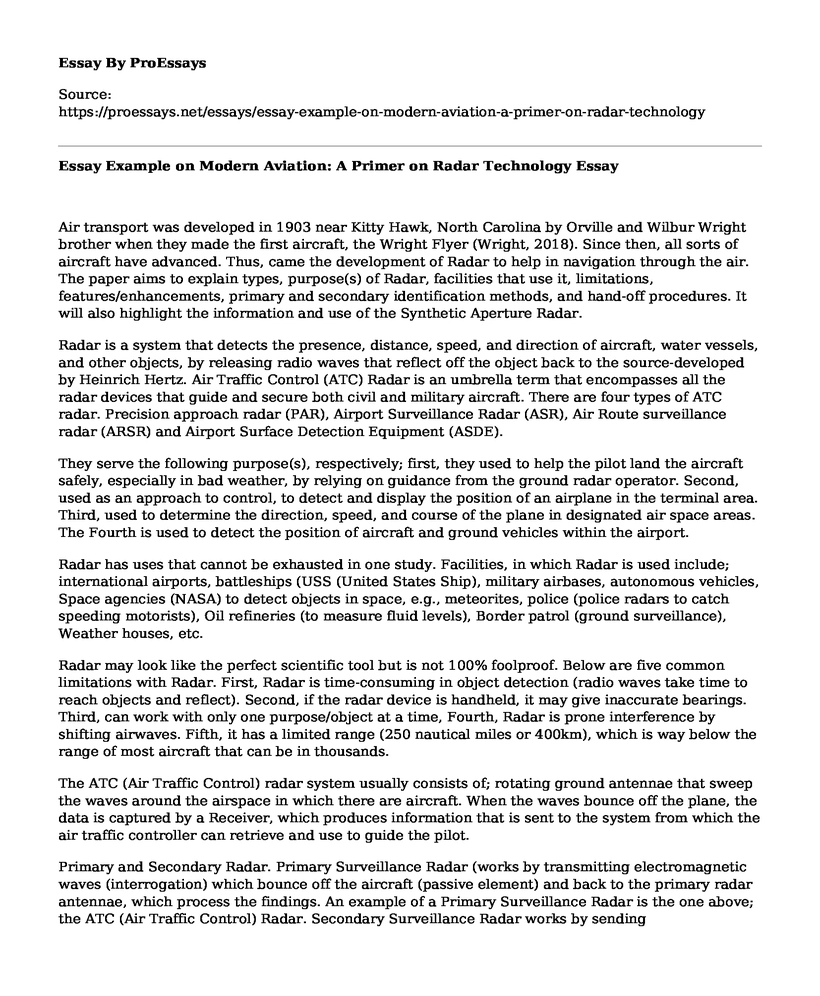Air transport was developed in 1903 near Kitty Hawk, North Carolina by Orville and Wilbur Wright brother when they made the first aircraft, the Wright Flyer (Wright, 2018). Since then, all sorts of aircraft have advanced. Thus, came the development of Radar to help in navigation through the air. The paper aims to explain types, purpose(s) of Radar, facilities that use it, limitations, features/enhancements, primary and secondary identification methods, and hand-off procedures. It will also highlight the information and use of the Synthetic Aperture Radar.
Radar is a system that detects the presence, distance, speed, and direction of aircraft, water vessels, and other objects, by releasing radio waves that reflect off the object back to the source-developed by Heinrich Hertz. Air Traffic Control (ATC) Radar is an umbrella term that encompasses all the radar devices that guide and secure both civil and military aircraft. There are four types of ATC radar. Precision approach radar (PAR), Airport Surveillance Radar (ASR), Air Route surveillance radar (ARSR) and Airport Surface Detection Equipment (ASDE).
They serve the following purpose(s), respectively; first, they used to help the pilot land the aircraft safely, especially in bad weather, by relying on guidance from the ground radar operator. Second, used as an approach to control, to detect and display the position of an airplane in the terminal area. Third, used to determine the direction, speed, and course of the plane in designated air space areas. The Fourth is used to detect the position of aircraft and ground vehicles within the airport.
Radar has uses that cannot be exhausted in one study. Facilities, in which Radar is used include; international airports, battleships (USS (United States Ship), military airbases, autonomous vehicles, Space agencies (NASA) to detect objects in space, e.g., meteorites, police (police radars to catch speeding motorists), Oil refineries (to measure fluid levels), Border patrol (ground surveillance), Weather houses, etc.
Radar may look like the perfect scientific tool but is not 100% foolproof. Below are five common limitations with Radar. First, Radar is time-consuming in object detection (radio waves take time to reach objects and reflect). Second, if the radar device is handheld, it may give inaccurate bearings. Third, can work with only one purpose/object at a time, Fourth, Radar is prone interference by shifting airwaves. Fifth, it has a limited range (250 nautical miles or 400km), which is way below the range of most aircraft that can be in thousands.
The ATC (Air Traffic Control) radar system usually consists of; rotating ground antennae that sweep the waves around the airspace in which there are aircraft. When the waves bounce off the plane, the data is captured by a Receiver, which produces information that is sent to the system from which the air traffic controller can retrieve and use to guide the pilot.
Primary and Secondary Radar. Primary Surveillance Radar (works by transmitting electromagnetic waves (interrogation) which bounce off the aircraft (passive element) and back to the primary radar antennae, which process the findings. An example of a Primary Surveillance Radar is the one above; the ATC (Air Traffic Control) Radar. Secondary Surveillance Radar works by sending electromagnetic waves (interrogation), which reach the aircraft (active element).
A transponder on the aircraft sends a return signal back complete with information like; the altitude, speed, location, and 'squawk code' of the aircraft. A 'Squawk code' is a four-digit code given as identification to aircraft en route in a given region/airspace). An example of a Secondary Radar is the IFF Radar, i.e., Identification Friend or Foe Radar. They are thus used in military operations.
A synthetic Aperture Radar is a type of Radar used to create two or 3-Dimensional representations of things like; landscapes and geological formations (mountains, hills, valleys, etc.). It works by recording different wavelengths of electromagnetic waves bouncing off objects on the ground from a moving platform (aircraft or spacecraft). Thus the differences can tell the state of the landscape; longer wavelengths could mean that there is a valley or depression or water body while the shorter wavelengths show higher ground. The precision level varies by a deviation of few millimeters up to ten centimeters.
Landscapes can be both terrestrial (planet earth) and extra-terrestrial (other bodies celestial bodies or planets in space). It is used to make out the structure of such bodies and from that explorers or researchers can be able to learn. For example, the Surface/landscape of Venus was imaged by the Magellan Probe using a Synthetic Aperture Radar (Voosen, 2017).
References
Voosen, P. (2017). Jilted again, Venus scientists pine for their neglected planet.
Wright, O., & Wright, W. (2018). Early History of the Airplane. B&R Samizdat Express.
Cite this page
Essay Example on Modern Aviation: A Primer on Radar Technology. (2023, May 23). Retrieved from https://proessays.net/essays/essay-example-on-modern-aviation-a-primer-on-radar-technology
If you are the original author of this essay and no longer wish to have it published on the ProEssays website, please click below to request its removal:
- Aviation Human Factors Essay
- Essay Sample on The Effect of the Wide Availability of Smartphones
- Paper Example on Bombardier 6500: Cost Factors & Performance Features
- Essay Example on the Debate Over Nuclear Power: Natural Gas vs. Nuclear
- 96% of Air Crashes in 2014: The Unsatisfactory Reality - Essay Sample
- Essay Sample on Ryanair: Managerial Roles and Their Impact on Success
- Report Example on Safety Reasons for Large Aircrafts







